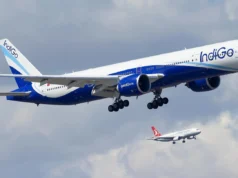Officials verified that a SpiceJet turboprop plane lost a wheel immediately after taking off from Gujarat’s Kandla airport on Friday, September 12, but made a safe landing in Mumbai.
An outer wheel from a SpiceJet Q400 flying from Kandla to Mumbai was discovered on the runway on September 12 following takeoff. The airline said in a statement that the plane made a safe landing and continuing its flight to Mumbai.
Following a flawless touchdown, the plane taxied to the terminal, and everyone got off without any problems. According to sources, the Mumbai airport made an emergency landing as a precaution. Six tires are installed on a Q400 aircraft. At first, it was unclear how many people were on board.
The event occurred one day after a potential mechanical problem on another SpiceJet flight. Following a probable tailpipe fire reported by another aircraft on the ground, a Boeing 737-8 flying from Delhi to Kathmandu returned to the bay at Indira Gandhi International Airport on Thursday.
“A SpiceJet plane that was supposed to fly from Delhi to Kathmandu on September 11, 2025, returned to bay when another plane on the ground reported what seemed to be a tailpipe fire. The pilots chose to return as a preventive safety measure even though there were no cautions or indicators in the cockpit, the airline informed PTI.
After undergoing engineering inspections and finding no anomalies, the flight took off for Kathmandu. After over seven hours of delay, the plane made a safe landing in Nepal at approximately 5:10 p.m.
According to the aviation safety web SKYbrary, a tailpipe fire, often referred to as an internal fire, usually happens within the gas flow channel of a jet engine, frequently during start-up or shutdown while the aircraft is on the ground.
The events occur while SpiceJet is facing financial and operational difficulties. The carrier has been running a smaller fleet and posted a net loss of ₹238 crore for the June quarter, down from a profit of ₹150 crore the previous year. By the end of June, only 21 of the 56 aircraft were in flight; the others had been grounded because of technical or budgetary difficulties.
By April 2026, the airline hopes to have at least ten aircraft back in service, with four to five of those aircraft scheduled to return before the winter travel season. With 19 engines sent to overhaul facilities across the globe, including Boeing 737 NG, Boeing 737 MAX, and Q400 aircraft, maintenance and repair slots have already been reserved.







